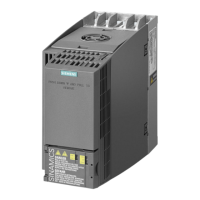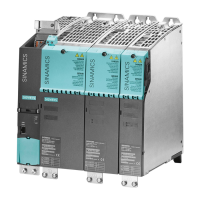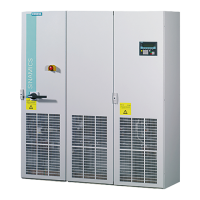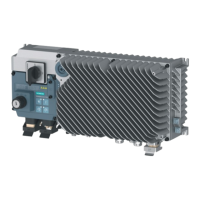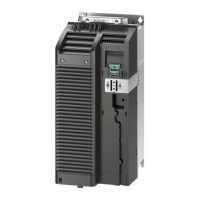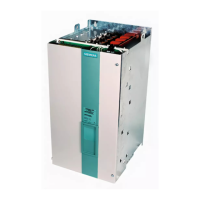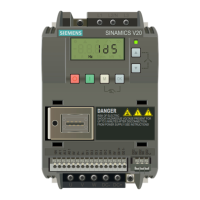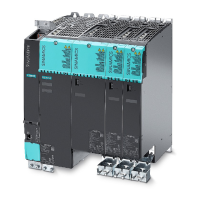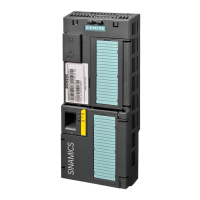Fundamental Principles and System Description
Engineering Information
SINAMICS Engineering Manual – November 2015
Ó Siemens AG
21/528
input voltage or higher if the parameters of ratio V
DCLink
/ V
Line
are set to sufficiently high values on the Active Infeed.
This is described in the section “SINAMICS Infeeds and their properties”, subsection “Active Infeeds”.
Note:
Pulse-edge modulation PEM is available only for vector-type drive objects (vector and V/f control modes) in
combination with current controller clock cycles of ≥ 250 μs and is generally utilized on drives with asynchronous
motors. With servo-type drive objects (servo control mode), converters always operate with space vector modulation
SVM with automatic overmodulation. The reason for this is the slower dynamic response of the drive in operation with
pulse-edge modulation PEM. This is acceptable for many applications with vector control, but not for highly dynamic
applications with servo control.
1.1.3 The pulse frequency and its influence on key system properties
The pulse frequency of the inverter corresponds to the frequency at which the IGBTs are turned on and off in the
inverter phases in operation with space vector modulation SVM. It is an important parameter which has a significant
influence on various properties of the drive system. It can be varied within certain given limits. It might be useful to
increase the pulse frequency from the factory-set value in order, for example, to reduce motor noise. However, it
might also be essential to increase the pulse frequency, for instance, when higher output frequencies are required or
to allow the use of sine-wave filters at the converter output.
An overview of the following aspects of the pulse frequency is given below:
· The pulse frequency factory settings,
· the permissible pulse frequency adjustment limits,
· the interrelationships between current controller clock cycle, pulse frequency and output frequency,
· the effects of the pulse frequency on various properties of the drive system, and
· the important points to note in relation to motor-side options (motor reactors, motor filters).
1.1.3.1 Factory settings and ranges of pulse frequency settings
The factory setting of the pulse frequency f
Pulse
of the motor-side inverter for SINAMICS G130, G150, S150 and S120
(Chassis and Cabinet Modules formats) with vector-type drive objects (vector and V/f control modes) is 2.0 kHz with a
current controller clock cycle T
I
= 250 μs or 1.25 kHz with a current controller clock cycle T
I
= 400 μs in accordance
with the following table.
Line supply voltage Output power Rated output current Factory setting of
pulse frequency f
Pulse
and current controller
clock cycle T
Maximum possible
pulse frequency of
power unit
380 V to 480 V 3AC ≤ 250 kW ≤ 490 A 2.00 kHz / 250 μs 8.0 kHz
≥ 315 kW ≥ 605 A 1.25 kHz / 400 μs 7.5 kHz
500 V to 600 V 3AC All power ratings All currents 1.25 kHz / 400 μs 7.5 kHz
660 V to 690 V 3AC All power ratings All currents 1.25 kHz / 400 μs 7.5 kHz
Unit-specific factory setting of pulse frequency and current controller clock cycle for SINAMICS G130, G150, S150 and for
SINAMICS S120 Motor Modules (Chassis and Cabinet Modules formats) for vector-type drive objects (vector and V/f
control modes)
The pulse frequency factory setting can be increased in discrete steps. The possible settings for the pulse frequency
f
Pulse
are dependent upon the current controller clock cycle setting T
I
according to the following equation
f
Pulse
= n • (1 / T
I
) where n = ½, 1, 2, 3, ... .
In addition the limits given by the relevant power units according to the table above, as well as the current derating
factors specified in the chapters about specific unit types must be taken into account. Depending on these criteria,
the pulse frequency can therefore be raised to 8 kHz or 7.5 kHz, depending on the unit type. It is possible to switch at
any time between pulse frequencies, which are calculated for a constant current controller clock cycle setting
according to the equation given above, for vector-type drive objects (vector and V/f control modes), even when the

